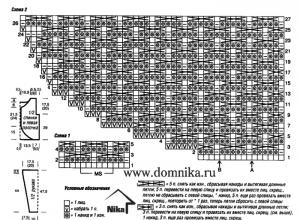Dog made of corrugated cardboard. Master class with step-by-step photos
The crafts look very impressive.
Recently, my daughter and I discovered a completely new use for corrugated cardboard - three-dimensional crafts.
Volumetric crafts made from corrugated cardboard are easy to make. They can become a child's toy or interior decoration. But we found another use for them - .
You will need:
- sheets of corrugated cardboard of different colors;
- scissors;
- ruler;
- PVA glue;
- shifty eyes;
- thin ribbon or beautiful thread.
Preparing for the craft
We cut the sheets of corrugated cardboard into strips 1 cm wide. For some small parts, narrow strips of 0.5 cm will be needed. From these strips we will roll circles - the basis for crafts.
Looking ahead, I will say that for the manufacture of large parts (head, torso) you will need a strip 1-2 meters long. Standard sheets of corrugated cardboard are about 28 cm long. Therefore, cut the required number of strips (3-4 strips for example) and during the rolling process simply glue them next to each other.
The scheme of all crafts is the same. The only difference is in the scenery. Let's look at the manufacture of basic parts using the example of a tiger cub.
1. For the head you will need a strip 1 cm wide and 1 meter long.
We cut strips along the length of the sheet, measure and determine how many strips we need up to a meter (usually 3-4 strips). Then we take the first strip and twist it into a tight circle. We glue the end, and next to the joint we glue another strip.

For the muzzle you will need a strip 0.5 cm wide and 50 cm long.
For ears: width 1 cm, length 16 cm.
For the spout: width 0.5 cm, length 7 cm.
2. For the torso:
- one orange stripe 1 cm wide, 50 cm long.
- one white stripe 1 cm wide, 50 cm long.
3. For the paws: 4 strips 1 cm wide and 16 cm long.
The process of creating a tiger cub from corrugated cardboard
We twist a circle for the head, a circle for the muzzle, a nose, and two ears, gluing the ends of the corrugated cardboard. Using the circles for the ears, we form triangles with our fingers.
When twisting, we try to make the first turns tightly.
My daughter and I did this: I started rolling it tightly and passed it to Anya. When the tape ran out, Anya re-glued it and rolled it further. Then I held the circle until the glue set, at which time I began to twist the second part.
When all the parts are ready, we glue them together, forming the face of the tiger cub and decorate it as we wish. Our tiger turned out to be angry - this is Anya’s idea - a saber-toothed tiger from “The Wizard of the Emerald City”.

By analogy, we form the torso.
To give volume to a corrugated cardboard craft, you need to squeeze out the middle of the circle with your finger, forming a dome. For strength, coat the inside with PVA glue. In a tiger cub, volume can be created on the tummy.
Christmas tree toys made of corrugated cardboard
To make a Christmas tree decoration, when twisting the head in the last circle, insert a thin ribbon and secure it with glue. We didn't do this, since the idea for Christmas tree decorations came later.
But no problem. In the intervals, we will insert a regular thread using a needle and hang the tiger cub on the Christmas tree. And we’ll make the next toy – a three-dimensional snowman – as it should be.

photo from the Internet
I found a lot of ideas for crafts made from corrugated cardboard in the book
MARINA TSYBANOVA
IMG]/upload/blogs/26e822f27947fc7d062defd38a2d4204.jpg.jpg IMG]/upload/blogs/c0f5304cd86fa343c9b9f351ea6efc2f.jpg.jpg Paper and cardboard– the most common and easily processed materials. One of my kids' favorite activities is applique and design from corrugated cardboard. These activities develop perseverance in children and help them think creatively. I offer several simple samples. To applique it could have been done faster and easier; I give the children stencils and patterns. When working with children during artistic creativity, I put target: this is the development of sensory skills, fine motor skills of the hands, spatial imagination, technical and logical thinking, eye; ability to navigate various types of information. The development of sensory perception is facilitated by processing operations paper:
1. bending;
2. cutting;
3. skill of stenciling
4. sticking.
I think it is very important that during production appliqués the child gains confidence in his abilities, manual dexterity and flexibility in his fingers appear, and the accuracy of his work improves. Gradually, children develop such qualities as determination, perseverance, and the ability to complete the work they start.
Imagine and create! Develop your children!





To make this craft you need to prepare strips of corrugated cardboard.
In our case, all strips are 50 cm long and 1 cm wide.
Stripe colors:
Dark blue,
Pink,
.jpg)
You also need to prepare PVA glue, scissors, plastic eyes and a spout.
Dog made of corrugated cardboard. Step-by-step process with photos
Dog's head.
Glue together 3 strips in length.
.jpg)
.jpg)
Use your fingers to form a hemisphere so that on one side the sphere is more extended.
.jpg)
Coat the inside of the part with PVA glue with a brush.
.jpg)
We will also make the second part.
.jpg)
After the glue has dried, glue the hemispheres together. Cover the joint with a strip.
.jpg)
Dog face
We glue together one whole and ¼ strips of yellow paper in length. Count three cloves from the edge and roll the oval.
.jpg)
We give it a convex shape with our hands and coat it with glue from the inside.
.jpg)
.jpg)
Dog body
Glue together 5 strips of corrugated paper and roll into a thick disk.
.jpg)
.jpg)
Upper paws
Cut the strip in half. We twist it into a tight disk, pull it out, and fix it from the inside with glue.
.jpg)
To make the lower part of the paw, you need to cut the strip in half and lengthwise, i.e. take strips measuring 0.5 cm by 25 cm. Take one of these strips, twist it into a tight disk, and slightly pull it out, coating the inside with glue.
.jpg)
Glue the dried parts together.
.jpg)
We make the second upper leg in the same way.
Lower paws
We count 5 cloves on the pink strip, bend it, twist it into a tight oval, pinch it on one side, giving it the shape of a drop.
.jpg)
We cover the part with a yellow strip for 2 turns.
We also twist the second part.
.jpg)
We curl our little fingers.
.jpg)
Glue the fingers to the paws.
.jpg)
Dog ears
Take half the yellow strip and cut it in half lengthwise. We count three cloves, twist the ovals, pressing on one side.
.jpg)
You can make the ears different colors or black.
Doggie tail
Cut the yellow strip in half. We coat the part along the edge with PVA glue and twist it in a spiral.
.jpg)
Bone
Let's make a treat for the dog. To do this, cut the white strip in half lengthwise. We divide one segment into 4 equal parts. We twist 4 small disks. We cut the other piece in half, count 4 cloves and twist the oval. Glue the tip. Give it a rectangular shape.
.jpg)
Glue all the elements together.
.jpg)
Glue all the parts together.
First we glue the muzzle to the head and to the body
.jpg)
Glue on the ears, upper paws and collar.
.jpg)
Glue the eyes and nose onto the muzzle. We make a mouth out of black paper.
.jpg)
Glue the lower legs.
.jpg)
.jpg)
Glue the tail.
.jpg)
Add your favorite bone.
.jpg)
Our dog is ready.
.jpg)
.jpg)
PS).
search
Tips for photographing crafts) or filmed (see how to upload a video).
Attention: Terms of use
Irina Arkadieva
Crafts and toys from corrugated cardboard.
Corrugated cardboard is a packaging material that is always with us. It helps preserve or extend life for many things. After using this packaging, we usually throw it away without thinking about what corrugated cardboard is a valuable raw material for artistic creativity.
With the help of your imagination and work corrugated cardboard can be turned into original products: various toys, boxes, vases, flowers, fruits, wall panels.
Necessary materials and tools for working with corrugated cardboard.
Will need:packaging cardboard-unnecessary boxes(requires prior processing) ; scissors, awl, brushes, PVA glue or Moment glue, a simple pencil.
Preparation of packaging corrugated cardboard for work.
Unfold and straighten the box;
Cut off damaged areas;
Place the workpieces on a flat surface;
Pour water into the container and wet the surface with a damp cloth. cardboard
sheet so that no puddles or sags form;

When the top paper layer gets wet, carefully remove it, leaving
corrugated layer intact;

Straighten cardboard, secure it so that the sheet does not curl up and
dry it, because all operations must be performed only with good
dried cardboard;

Basic principles working with corrugated cardboard and creation of standard blanks.
1. Slice cardboard strips(strips 0.5 cm wide).

2. Take a strip and spread glue on the smooth side.

3. Twist the strip.

4. Pull the middle out a little so that you get a hemisphere.

5. Glue the second hemisphere.

6. Connect both blanks end-to-end and glue them together with a strip corrugated cardboard,
it becomes the basis for many compositions.

Crafts and toys from cardboard.
Cover the jar with the prepared strips.

Decorate with flowers from hemispheres and leaves.

The apple is made on the principle of winding threads into a ball and from two hemispheres, inserting a toothpick stick and gluing a piece of paper.

Presented crafts (apples) made by children.

Baskets, casket.

Dog, mouse, pig.

Vases from jars.

We use them as napkin holders.
Latest site materials
Cosmetology
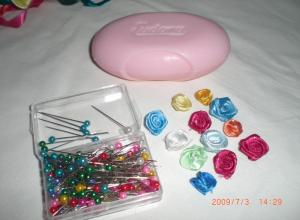
DIY crafts for sale made from ribbons
Master class “Basket with roses” My dear Bees, I want to offer you a master class on making a very beautiful gift “Basket with roses” To do this you will need the following: a set of different colored ribbons 10 meters of main ribbon (in my case
Cosmetology
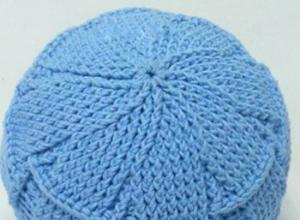
Crochet knitted hat for a boy: description of knitting Openwork crochet hat for a boy
Based on this crochet hat for a boy, it is easiest to understand the principle of knitting hats for men and teenagers with a convex geometric pattern. They can be very diverse, these hats with convex columns. They not only look good, but also
Horoscope
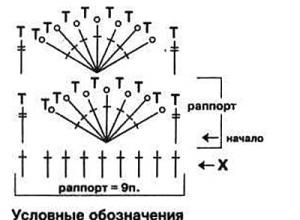
Crochet scarf patterns
A knitted scarf is a product that everyone needs. It will not only protect you from the cold, but also add style and elegance. Let's look at what models of scarves can be crocheted. A stylish option from Drops. A spectacular pattern for experienced craftswomen. Neoby
Health
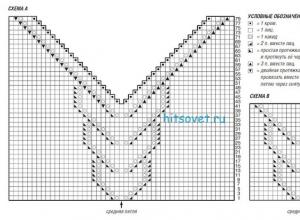
Knitted melange sleeveless vest
Bottom edge width: 88 (100,112,122) cm You will need: 500 (550,600, 700) g of blue-gray yarn (color 04917) Schachenmayr select C0RALITA (50% wool, 50% polyamide, 25 m/50 g); knitting needles No. 9-10 and No. 12.75. Twisted elastic band 1st row. (front side)
Health
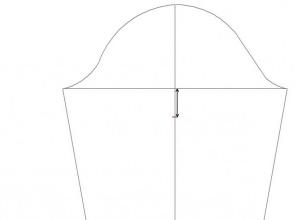
Pattern of a quilted demi-season jacket Pattern of a quilted jacket
Today, women's clothing stores offer such a large assortment that it may seem that sewing a women's windbreaker with your own hands, the patterns of which will be discussed in this article, is a completely unjustified activity. However, if you think about it, then
